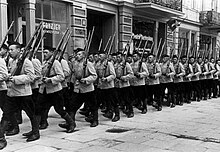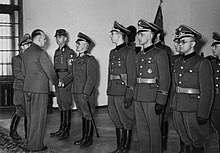Sonderdienst
| Sonderdienst | |
|---|---|
 Leaders ofGeneral Governmentduring inspection ofSonderdienstbattalions: from right,GeneralgouverneurHans Frank,Higher SS and Police LeaderGGHerbert Beckerand secretary of stateErnst Boepple | |
| Active | 6 May 1940 — 1945 |
| Country | Occupied Poland |
| Allegiance | |
| Type | Paramilitarypolice reserve |
Sonderdienst(German:Special Services) were mostly non-GermanNaziparamilitaryformations created in the occupiedGeneral Governmentduring theoccupation of PolandinWorld War II.They were based on similarSSformations calledVolksdeutscher Selbstschutzoperating in theWarthegaudistrict of German-annexed western Poland in 1939.[1]
Sonderdienstwere founded on 6 May 1940 byGauleiterHans Frankwho was stationed in occupiedKraków.[1]Initially, they were made up of ethnic GermanVolksdeutschewho lived in Poland before the attack and joined the invading force thereafter. AfterOperation Barbarossabegan in 1941, they also included Sovietprisoners of warwho volunteered for special training, such as theTrawniki men(German:Trawnikimänner) deployed at all major killing sites of the "Final Solution".Many of those men did not know German and required translation by their native commanders.[2][3]: 366 TheAbteilung Sonderdienst(Department of Special Services) was subordinate toOberkommando der Wehrmachtsabotage division under ColonelErwin von Lahousen(1 September 1939 – July 1943), and ColonelWessel Freytag von Loringhoven(July 1943 - June 1944).[4]
Background
[edit]

TheRepublic of Polandwas a multi-ethnic country beforeWorld War II,with almost a third of its population comprising minority groups: 13.9% Ukrainians; 10% Jews; 3.1% Belarusians; 2.3% Germans and 3.4% Czechs, Lithuanians, and Russians. Members of theGerman minorityresided predominantly in the lands of the former German Empire but not only.[5]Germans in particular were hostile towards the existence of the Polish state after losing their colonial privileges at the end ofWorld War I.[6]German organizations in Poland such asDeutscher Volksverbandand theJungdeutsche Parteiactively engaged in espionage for theAbwehr,sabotage actions, weapons-smuggling and Nazi propaganda campaigns before the invasion.[7]In late 1939 through spring of 1940 the GermanVolksdeutscher Selbstschutztook active part in themassacres of civilian Poles and Jews.[8]
In the summer of 1940, theSonderdienstalong with allSelbstschutzexecutioners were formally assigned to the head of the civil administration for the newly formedNazi era Gau.[2]Trained by native Germans under the leadership ofHeinrich Himmler's associateLudolf Jakob von Alvensleben,many of them joined theSchutzstaffelorGestapoduring the following year.[2]
Operation Barbarossa
[edit]
Some 3,000 men served with theSonderdienstin the General Government.[2]After the Nazi Germanconquest of eastern Europe,known asOperation Barbarossa,GruppenführerGlobocnikeagerly sought another source of manpower. The citizens of these countries who spoke German became highly valued because of their ability to communicate in Ukrainian, Russian, Polish and other languages of the occupied territories.[9]The training ofnon-German European auxiliarieswas arranged at theTrawniki concentration campby SS-HauptsturmführerKarl Streibel.Instructed by Globocnik to start recruiting behind the front lines of Operation Barbarossa, Streibel trained 5,082 mostly Ukrainian guards before the end of 1944. They were organized into two newSonderdienstbattalions.[10]According to the postwar testimony of SS-OberführerArpad Wigandduring his war crimes trial in Hamburg, only 25 percent of them even spoke German.[2]
During Final Solution of Operation Reinhard
[edit]TheHiwiWachmännerguards known as "Trawniki men"(Trawnikimänner) served at death camps as well as all major killing sites of the "Final Solution" throughoutOperation Reinhard.They took an active role in the executions of Jews atBelzec,Sobibor,Treblinka II,Warsaw(three times),Częstochowa,Lublin,Lwów,Radom,Kraków,Białystok(twice),Majdanekas well asAuschwitz,not to mention Trawniki duringAktion Erntefestof 1943,[10]and the remaining subcamps ofKL Lubl
inincludingPoniatowa concentration camp,Budzyn, Kraśnik, Puławy,Lipowa 7 camp,as well as during massacres inŁomazy,Międzyrzec,Łuków,Radzyń,Parczew,Końskowola,Komarówkaand all other locations, augmented by the SS and theReserve Police Battalion 101fromOrpo.[2][11]After the war ended, the last 1,000Hiwi volunteersforming theSS Battalion Streibelblended in with the civilian population in West Germany and disappeared from sight.[3]
References
[edit]- ^abThe Erwin and Riva Baker Memorial Collection (2001).Yad Vashem Studies.Wallstein Verlag. pp. 57–58.ISSN0084-3296.
- ^abcdefBrowning, Christopher R.(1998) [1992]."Arrival in Poland"(PDF).Ordinary Men: Reserve Police Battalion 101 and the Final Solution in Poland.Penguin Books. pp. 51, 98, 109, 124. Archived fromthe original(PDF)on 19 October 2013.RetrievedMay 1,2013.
- ^abBlack, Peter R. (1 September 2006). "Police Auxiliaries for Operation Reinhard". In Bankir, David (ed.).Secret Intelligence and the Holocaust: Collected Essays from the Colloquium at the City University of New York.Enigma Books. pp. 331–348.ISBN978-1-929631-60-5.Retrieved20 January2024.
- ^Andreas Altenburger (2012)."Abteilung Abwehr II Sonderdienst".Amt Ausland / Abwehr (A. Ausl./Abw.)(in German). Lexikon der Wehrmacht – Amt Ausland / Abwehr.Retrieved18 May2014.
- ^Wojciech Roszkowski (4 November 2008)."Historia: Godzina zero".Tygodnik.Onet.pl weekly. Archived from the original on May 12, 2012.Retrieved18 May2014.
{{cite web}}:CS1 maint: unfit URL (link) - ^Roshwald, Aviel (2000).Ethnic Nationalism and the Fall of Empires: Central Europe, the Middle East and Russia, 1914-1923.Routledge.ISBN1134682549.
- ^Popularna Encyklopedia Powszechna Wydawnictwa Fogra."Piąta kolumna w Polsce (The 5th column in Poland)".Militaria(in Polish). Encyklopedia WIEM. Archived fromthe originalon May 17, 2017.RetrievedAugust 13,2012.
- ^Piąta kolumna (The Fifth Column: Jungdeutsche Partei, Deutsche Vereinigung, Deutscher Volksbund, Deutscher Volksverbarid).Kampania Wrześniowa 1939.pl (2006).
- ^Arad, Yitzhak(1987).Belzec, Sobibor, Treblinka. The Operation Reinhard Death Camps(Google Books preview).Bloomington, Indianapolis: Indiana University Press. p. 22.ISBN0-253-21305-3.
- ^abHolocaust Encyclopedia."Trawniki".United States Holocaust Memorial Museum. Permission granted to be reused, in whole or in part, on Wikipedia;OTRSticket no. 2007071910012533.Retrieved19 May2014.
- ^Mgr Stanisław Jabłoński (1927–2002)."Hitlerowski obóz w Trawnikach".The camp history(in Polish). Trawniki official website.Retrieved20 May2014.
{{cite web}}:CS1 maint: multiple names: authors list (link) CS1 maint: numeric names: authors list (link)
